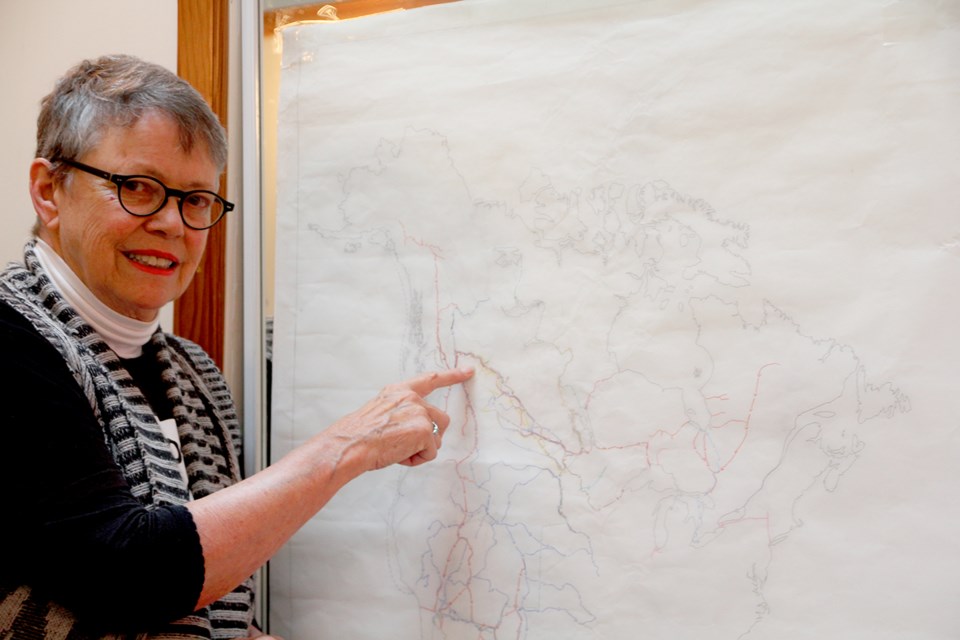Professional Agrologist, economist and Bowen Islander of 28 years Wendy Holm says the SITE C dam on BC’s Peace River and must be stopped, and she’s ready to be arrested in order to do it.
“This is really an issue of democracy,” says Holm. “It goes way beyond food security and water security.”
As an Agrologist and expert in food security, Holm was brought in as an expert witness for the Site C Dam’s environmental assessment process.
From a food security perspective, she says that the dam will destroy enough farmland to meet the nutritional needs of more than a million British Columbians per year.
“The Peace River Valley is made up of alluvial soils,” says Holm. “When I talk to audiences who are not familiar with agriculture, I always tell them that if you were a vegetable you would pray your children would grow up in alluvial soils cause they are ideal for horticulture. We import more than 60 percent of vegetables we could grow. With its alluvial soils and class one climate for agriculture, the Peace River Valley has the cropping capability of the Fraser Valley but with higher yields, because of the longer days throughout the summer. Instead we are dependent on drought-stricken California for produce.”
In their environmental assessment for the dam, Holm says, BC Hydro failed to properly measure the amount of farmland that will be lost and accounted for only 13 percent of the impacted land. She adds that the land they did account for was tremendously undervalued.
“As an expert witness I told them these things,” says Holm after going in depth into the numbers representing amount of land and land-value. “The chair of the Federal-Provincial panel reviewing the project recommended that it be reviewed by the BC Utilities Commission which would’ve killed the project because it will drastically increase the price of electricity, but the government did not allow that to happen.”
In 2015, the former chair of the Federal-Provincial assessment panel for Site C, Harry Swain, spoke publicly against the government in its rush to start construction on the dam saying that a delay in the project would give time to verify costs, how much energy the province needs, and negotiate with First Nations. However, BC Energy Minister Bill Bennett responded by saying Swain is misinformed, and that the project has been “on the books” for 30 years.
Wendy Holm looks back more than 30 years for the first plans for Site C Dam. In the 1950s, the US Army Corps of Engineers were charged with the responsibility of making sure America did not run out of water. Engineering firms tabled many proposals, one of which was called the North American Water Power Alliance (NAWAPA). The plan has been described as a massive continental plumbing project made up of 369 dams, canals, pipelines tunnels and pumping stations in order to divert water from Alaska into the Southern US. It was backed by Prime Minister Lester B. Pearson and BC Premier W.A.C. Bennett, but enraged many Canadians including General Andrew McNaughton, who is credited with crushing the project.
Holm says that NAFTA has cleared the barriers that prevented such projects from moving forward, and with “Site A” (the W.A.C. Bennett Dam) and the “Site B” (the Peace Canyon Dam) built, Site C will complete plans drafted back in the 50’s to supply northern water to southern cities when the need arises.
Holm says she’s been trying on twitter and social media to raise the global profile of Site C dam, including tweets to Prime Minister Justin Trudeau.
“There are so many voices, globally, coming out against this project I’m hoping I can embarrass him into stopping it,” she says. “I’ve also been tweeting Yoko Ono, asking her to back the cause and let us record “Give THE Peace A Chance” with lyrics written for The Peace.”
“I guess I’m just a girl who can’t take no for an answer,” says Holm. This week is the official launch of the Yellow Stakes Campaign. “For a tax deductible donation of a hundred dollars, a yellow stake will be planted on Ken and Arlene Boon’s farm, which BC Hydro wants to expropriate before Christmas. Stakes will be planted, symbolically, between the Boon’s and BC Hydro’s equipment. I am hoping there will be stakes there from all over the world. One hundred percent of the funds raised in the Yellow Stakes Campaign will go to support the legal fight by Profit River and Moberly Lake First Nations to stop Site C.”
And of course, Holm is hoping for support from Bowen Island. “As an island,” she says, “we should have a particularly strong understanding of the finite and respect for the commons. The Peace River Valley is our agricultural commons. It has been here for millennia, and it is meant to feed communities into the future. I truly believe that my grandchildren’s, grandchildren have legal rights that should be enforceable today and those rights should say that when it comes to the commons, we have an obligation to them to make it better, not destroy it.”
To plant your stake in the Peace, go to: http://www.stakeinthepeace.com



